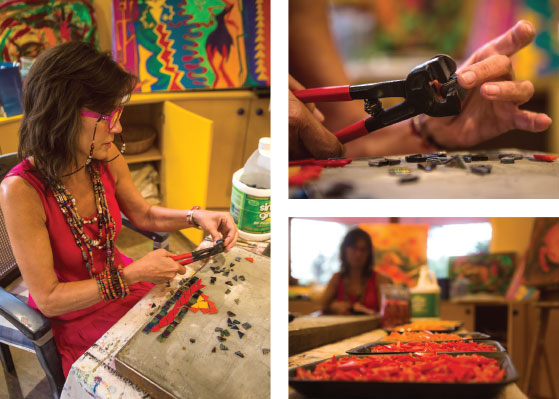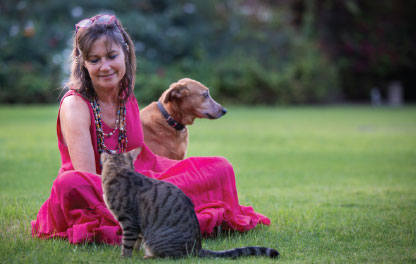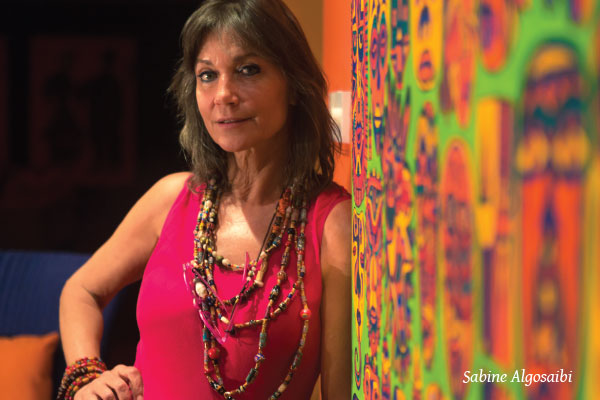Sabine Algosaibi’s essence is on every inch of the impressive property she calls home, yet she manages to remain an enigma. Ankita Mamgain tries to uncover the many layers that make up this elusive artist.
The March sun had a generous presence in Sabine Algosaibi’s 1,905sq/m villa. The 55-year-old met me with a beautiful smile that travelled straight to her eyes. She wore a crimson dress that adorned her delicate frame and a hat that brought out the bohemian child within. I met her in her magnificent home in Janabiya where her friend Steven and dog Salsa occasionally kept us company.
The first thing that strikes you is the feast of colour that surrounds Sabine. How did she come to develop this variegated sanctuary for herself in a desert? The answer has much to do with her inherent sensibilities as a person, deeply influenced by a childhood spent in Africa.
Born in Austria, she moved to South Africa with her mother and step-father at the age of six.
“We were always on the road. I don’t remember a single weekend in my childhood when I was at home. [We were] always camping outside, exploring new areas,” she reminisces. And there was a lot of moving. She went to 13 different schools and moved house 21 times in eight years.
“As a child it was really exciting,” she says of the impact of such a life. “It brought a lot of openness to my personality; I learnt to take people for what they are, to be more tolerant as we were always with all kinds of people.” It also made nature a huge part of her life and, of course, fuelled her love for colours. “I am a colour maniac; I think that has a lot to do with South Africa.”
After high school, she left for Switzerland to study commercial law. “I was following a boyfriend, so I took up whatever course was available, just to be able to be there,” she declares with a matter-of-fact innocence.
So what brought a person so free, open and uninhibited to the Middle East? “Love,” she says. “Oh, I’m such a hopeless romantic!”
At 21, Sabine visited her parents, in Khobar, Saudi Arabia (KSA), and met her husband at a party. She moved in with him and never left. This was the turning point for her, as up until then, her uncontainable energy had always had a vent. In KSA, these avenues were very limited.
“KSA really bored me. My husband was really busy and I didn’t do the tea party thing; I wanted to do something with my hands. I didn’t know what, but it had to be something with my hands.”

She found a book of pottery she had purchased in Austria, got the supplies and unleashed her wild creativity that had been lying dormant for years.
“I took over his garage, made myself a studio and I taught myself pottery. I ended up doing all the tiles for this house myself,” she says.
As her family grew, pottery became more challenging. “I thought, I’ve never painted before, so let me paint. So I got myself a canvas and acrylics and started painting. I didn’t know what I was doing, I just went for it,” she says excitedly.
Thirteen years ago she came to Bahrain and that ignited a new fire, propelling her into more ambitious projects such as cement statues.
“When I came to Bahrain, after Saudi, it felt like walking into paradise. I could drive; I was allowed to take up courses. I took a lesson in watercolour painting, which is not my thing at all, but just the fact that I was allowed to do it made me feel great,” she says.
“I went crazy with the house,” which Sabine admits is her biggest project to date. She also didn’t like any of the garden statues she saw, so decided to make them herself.
“An Indian gentleman taught me how to weld two pieces of metal together over a weekend and I started welding and doing cement statues. That was some hard labour! The first ones I did completely by myself, no help at all.” She now uses papier mâché as it is much easier to work with.
Sabine’s art is just as diverse and multifaceted as her personality. She isn’t your most straightforward artist who dwells in only one medium. From what I understand, much as she appreciates stability, her life’s been all about transition and she revels in the challenges novelty brings.
Almost cartoon-like in its aesthetic, her work is colourful, wacky, with layer upon layer of richly imagined elements that depict an almost child-like understanding of the world. However, it can still impart a deep sense of struggle, fear and tribulation.
And her process seems quite straightforward. The starting point is usually colour, something she dreams of and a word, which becomes the central theme. I saw a large painting on the wall and asked her what word she had in mind for it. “What mask do we wear every day? Because we all do, don’t we?” she replied.
What she wants to communicate through her art is essentially life, fun and joy, as she believes in finding the joy in everything. “My husband passed away four years ago and we went through a really hard time,” she explains. “The mourning was the hardest. And what helped was the joy that colour and movement brought. I did a lot of dancing. It was therapeutic.”
Personal narratives invariably enter her colourful kaleidoscopes and sometimes the experience transforms from a joyful expression to being profoundly cathartic.
A body print piece she’s doing in Austria, based upon the word ‘submission’, is proving to be particularly challenging. “I am having a hard time painting that one. A lot of my Saudi dreg is coming out and it’s not very positive. I keep painting it over with black.”
Interestingly, she did not know she had the creative vein as a child, since in her school, if you were not good at math, you couldn’t do art.
 Coming back to Bahrain and her home, she explains that the words for this project were ‘family’ and ‘protection’. She took her rough sketches to Argentinean architect Felipe Yofre who ‘got her’ immediately. She has now opened the villa to local artists, who use it as their studio, rehearsal space or to just meet and brainstorm. “I believe the more you give, the more you get. When I have young and creative people walking in, it gives me joy.”
Coming back to Bahrain and her home, she explains that the words for this project were ‘family’ and ‘protection’. She took her rough sketches to Argentinean architect Felipe Yofre who ‘got her’ immediately. She has now opened the villa to local artists, who use it as their studio, rehearsal space or to just meet and brainstorm. “I believe the more you give, the more you get. When I have young and creative people walking in, it gives me joy.”
She is thrilled with the current art scene in Bahrain and how it has grown over the last few years. “The Nest idea is just fabulous and Al Riwaq is doing a good job. Boho Baha is always doing amazing stuff. There are more galleries, people and courses. But, of course, we need to push for more,” she notes. Sabine also talks extensively about Art Reach, a project that involves schoolchildren. Mustafa Halwachi is one local artist who particularly impresses her.
“About 20 years ago I came over from Saudi with a friend to see a clairvoyant from Northern England that every body was raving about. She told me that you’re going to live in a house that has a very strong colour and you are going to be surrounded by water. Who would have thought?” she says reflectively.
She now splits her time between Austria, where she takes care of her mother, and Bahrain. Her daughters Latifa and Suheila, both students of media and communications, live in Milan and Switzerland respectively. I wondered, having moved around so much as a child, following her heart and discovering places and cultures absolutely alien to her, building a space with her own hands and then showing ready willingness to share it with the outer world, what was her idea of home?
Her response was immediate. “Home is where the heart is. You have to have love in your life and then it doesn’t matter where you are.” Does she feel loved in Bahrain? “Oh yes, very much so. Bahrain has been very good to me. I am very grateful.”


































